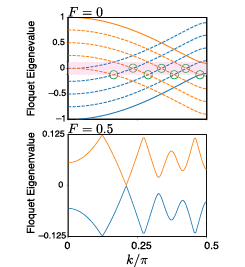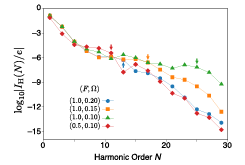Floquet-Theoretical Formulation and Analysis of High-Harmonic Generation in Solids
Tsunetsugu Group
High-harmonic generation (HHG) is a nonlinear optical phenomenon, and monochromatic input light irradiates a target medium to be converted to output with multiple high harmonics, which is an indispensable technology for the state-of-the-art ultrafast physical measurements. While atomic gases were traditionally used target media, recent experiments have achieved the high-harmonic generation in bulk solids [1]. However, it remains an open problem how the interaction of light with electrons in solids results in the conversion to higher frequencies.

Fig. 1. Energy dispersion of Floquet bands in two cases with different electron-light coupling F ∝ Ω-1E (electric field amplitude of input light): (upper) no coupling and (lower) non-zero coupling. Dimensionless frequency of input light is Ω = 0.25. The non-zero coupling F avoids crossings of replicas of the two original energy bands (solid lines in the upper panel).

Fig. 2. High-harmonic spectrum of electric current shown in logarithmic scale. The cutoff order Nmax represented by the arrow is proportional to F/Ω ∝E/Ω2.
In this study [2], we invoke the mathematical tool known as Floquet’s theorem to analyze the electron dynamics driven by light with single frequency Ω, which induces HHG in output light. We have tailored this theoretical framework for a simple lattice electron model in one dimension. This model is a tight-binding Hamiltonian with two bands which are controlled by site-alternating potentials, and electrons acquire a time-oscillating phase in their hopping amplitude due to their coupling to input light. We have obtained an analytical solution for the time evolution of electron wave function in the limit of no potential scattering, and proceed to analyze the effects of the potential scattering by a perturbation approach. While the highest frequency of HHG in the no-scattering limit is too low to explain the related experimental data, we have found that it becomes large enough as the scattering amplitude increases.
Our result [2] also predicts that the highest order in HHG is inversely proportional to the square of the input frequency, Nmax ∝ Ω –2, in contrast to the conventional scaling ∝ Ω–1 in atomic gases. This anomalous behavior deserves experimental confirmation. Besides, our Floquet-theoretical approach is general and thus applicable to various lattice systems. Therefore, for realizing effective HHG, it is useful to employ this approach and examine the effects of important characteristics of the model, such as dimensionality and symmetry of solids.
References
- [1] S. Ghimire et al., Nat. Phys. 7, 138 (2011).
- [2] T. N. Ikeda, K. Chinzei, and H. Tsunetsugu, Phys. Rev. A 98, 063426 (2018).
